

Las 10 nebulosas más increíbles captadas por el HUBBLE. Así es amigos este es un top de las mas increíbles nebulosas captadas por nuestro amigo, el telescopio espacial HUBBLE.

La nebulosa Ojo de Gato (NGC 6543) es una nebulosa planetaria en la constelación del Dragón. Estructuralmente es una de las nebulosas más complejas conocidas, en la que las imágenes de muy alta resolución del Telescopio Espacial Hubble han mostrado notables estructuras como nudos, chorros de material, burbujas y estructuras en forma de arco. Fue descubierta por William Herschel el 15 de febrero de 1786. Eleven Things that NASA Discovered. From The Anti-Gravity Handbook Compiled By D.
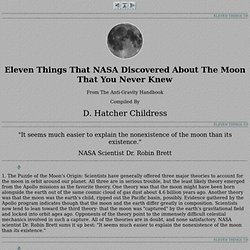
Hatcher Childress "It seems much easier to explain the nonexistence of the moon than its existence. " NASA Scientist Dr. 1. 2. 3. 4. 5. 6. 7. 8. We Choose the Moon: Pre-launch. - StumbleUpon. HERE IS TODAY. 100,000 Stars.
- StumbleUpon. - StumbleUpon. - StumbleUpon. Photo: STS-41D launch. Tech Billionaires Plan Audacious Mission to Mine Asteroids. There’s gold in them there hills.
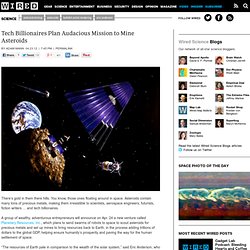
You know, those ones floating around in space. Asteroids contain many tons of precious metals, making them irresistible to scientists, aerospace engineers, futurists, fiction writers … and tech billionaires. A group of wealthy, adventurous entrepreneurs will announce on Apr. 24 a new venture called Planetary Resources, Inc., which plans to send swarms of robots to space to scout asteroids for precious metals and set up mines to bring resources back to Earth, in the process adding trillions of dollars to the global GDP, helping ensure humanity’s prosperity and paving the way for the human settlement of space. “The resources of Earth pale in comparison to the wealth of the solar system,” said Eric Anderson, who founded the commercial space tourism company Space Adventures, and is co-founder of a new company along with Peter Diamandis, who started the X Prize foundation, which offers prize-based incentives for advanced technology development. - StumbleUpon.
StumbleUpon. Scientists Discover Concealed Glaciers on Mars at Mid-Latitudes. Nov. 20, 2008.
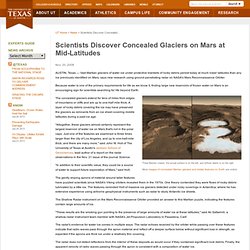
What Would Happen If You Fell Into A Black Hole? By: Natalie Wolchover Published: 04/13/2012 03:23 PM EDT on Lifes Little Mysteries In this weekly series, Life's Little Mysteries provides expert answers to challenging questions.

Black holes are without question some of the strangest places in the universe. So massive that they hideously deform space and time, so dense that their centers are called "points at infinity," and pitch- black because not even light can escape them, it isn't surprising that so many people wonder what it would be like to visit one. It's not exactly a restful vacation spot, as it turns out. - StumbleUpon. Asteroid 99942 Apophis 2004 MN4, impact countdown clock.
Record massive black holes discovered lurking in monster galaxies. University of California, Berkeley, astronomers have discovered the largest black holes to date ‑- two monsters with masses equivalent to 10 billion suns that are threatening to consume anything, even light, within a region five times the size of our solar system.
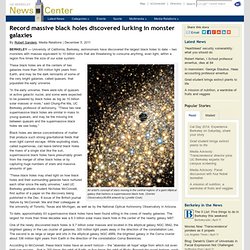
An artist's concept of stars moving in the central regions of a giant elliptical galaxy that harbors a supermassive black hole. (Gemini Observatory/AURA artwork by Lynette Cook) These black holes are at the centers of two galaxies more than 300 million light years from Earth, and may be the dark remnants of some of the very bright galaxies, called quasars, that populated the early universe.
Red dwarf star: Distant rocky planet 'could be future human home' PARIS — A rocky world orbiting a nearby star has been confirmed as the first planet outside our solar system to meet key requirements for sustaining life, scientists said on Monday.

Modelling of planet Gliese 581d shows it has the potential to be warm and wet enough to nurture Earth-like life, they said. It orbits a red dwarf star called Gliese 581, located around 20 light years from Earth, which makes it one of our closest neighbours. Gliese 581d orbits on the outer fringes of the star's "Goldilocks zone", where it is not so hot that water boils away, nor so cold that water is perpetually frozen. Instead, the temperature is just right for water to exist in liquid form. "With a dense carbon dioxide atmosphere — a likely scenario on such a large planet — the climate of Gliese 581d is not only stable against collapse but warm enough to have oceans, clouds and rainfall," France's National Centre for Scientific Research said in a press release.
46 Fabulous Photos of Endeavour's Last Ever Spacewalk - StumbleUpon. May 27th, 2011: the last spacewalk for NASA’s Endeavour astronauts.

Here, a fish-eye lens attached to an electronic still camera was used to capture this image of NASA astronaut Michael Fincke (top center) during the mission’s fourth session of extravehicular activity (EVA) as construction and maintenance continued on the International Space Station. Distances from the Sun - StumbleUpon. - StumbleUpon. How white holes (might) be created.
Exploratorium - StumbleUpon. Want to melt those years away?
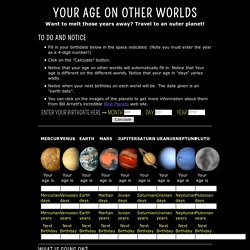
Travel to an outer planet! <div class="js-required"><hr> This Page requires a Javascript capable browser <hr></div> Fill in your birthdate below in the space indicated. (Note you must enter the year as a 4-digit number!) Click on the "Calculate" button. Hubble Catches a Warped Spiral Galaxy in Profile. The Hubble Heritage Team captured the warped structure of spiral galaxy ESO 510-13 so beautifully in this pretty space pic.

Behold, the product of galactic collisions. At least, that's one theory. Most spiral galaxies are flat disks made up of millions of stars and gas and planets and whatnot orbiting a galactic center (which is thought to be, at least in the case of large galaxies, a supermassive black hole). These disks are thought to flatten out the way they do by the nature of the collision of gas clouds early in a galaxy's lifespan.
But aberrations occur. Hubble Heritage Gallery of Images - StumbleUpon. WIKISKY.ORG - StumbleUpon.